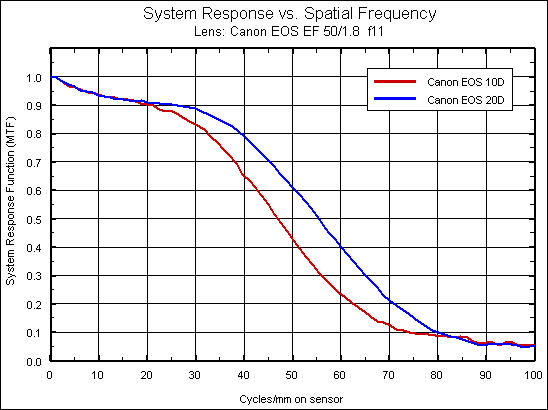
|
Canon EOS 20D DSLR Review
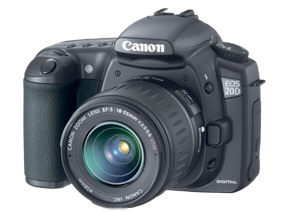 I've now had time to make a hands on evaluation of the Canon EOS 20D and to compare it with the Canon EOS 10D. Here's my take on things: SizePerhaps the most obvious characteristic of the 20D is how similar it looks to the 10D. It's very slightly smaller and very slightly lighter, but from a distance you'd be hard pressed to tell them apart! In actual fact the 20D is about 3.6 ounces lighter then the 10D and the width, height and depth are 5.7, 2 and 3.5 mm smaller.ControlsThere are some minor control differences. For example the on/off switch on the 10D has become a three way switch on the 20D which also controls the operation of the rear QCD (quick control dial). It has three positions, off, on with QCD disables and on with QCD enabled. The button on the 10D which changed movement of the image in zoom playback from horizontal to vertical has been replaced by a small 8-way "joystick", which is a little more convenient to use.Otherwise most of the camera and menu controls are essentially the same as a 10D and a 10D owner will feel quite at home with the 20D. TimingProbably the most obvious change to a 10D user will be the time it takes for the camera to "wake up" from standby mode or to "boot up" from the off state. On the 10D there's an obvious lag of around 2 seconds. On the 20D it's instant, or appears to be instant. Canon specs give a 0.2s startup time, but for practical use, it's instant. I don't sense any lag in actual use.The Digic II chip also speeds up writing to the CF card and using the faster cards the 20D can write data about 4x faster then the 10D. While the 10D was somewhat limited by it's own maximum write speed, the 20D does benefit from the use of a fast CF card (such as the Sandisk Ultra II and Extreme series cards) and can speed things up if you do a lot of "machine gun" shooting and full the image buffer. If you tend to shoot single shots or short bursts, the in camera buffer will take care of things and you'll never run into limitations due to CF write speed. If you use the USB connection to the camera, downloads are much faster with the 20D vs. the 10D since the 20D uses USB 2.0 and the 10D uses USB 1.1. ViewfinderLooking through the viewfinder at the camera information display the only real change is that the +/- 2 stops scale is now marked in 1/3 stop increments rather than 1/2 stop increments. Both cameras can select 1/3 or 1/2 stop shutter speed and aperture changes though via a custom function.Viewfinder size is the same but the 20D has a new "Precision Matte" screen which seems to make manual focusing a little easier. The 20D has 9 focus points arranged in a diamond pattern, while the 10D has 7 points in a cross. The marked area of the individual AF sensors is smaller on the 20D than the 10D. Whether this accurately represents the actual size of the sensors I don't know. The AF zone selected can be set to light up in red on both cameras. My impression is that AF illumination is brighter in the 20D viewfinder than in the 10D viewfinder. The new 8-way joystick control can be used to select the focus point in some modes. ShutterThe 20D now has a top shutter speed of 1/8000 and a flash sync speed of 1/250 (1/4000 and 1/200 in the 10D). The shutter (or at least the shutter sequence) is louder in the 20D than the 10D. This may be both a consequence of the new shutter (which uses stronger magnets) and the increased maximum shooting rate (5fps on the 20D, 3fps on the 10D). A faster shooting rate means the mirror also has to move faster, and a faster mirror carries more energy so it makes a louder noise when it stops! The difference in shutter noise is quite noticeable to someone used to the 10D. However it's not really any louder than a film camera like the EOS-3 once you take winding noise into account. It sounds loud because it's 6" from your ear of course!Also, by using a semiconductor switch rather than a mechanical contact, the flash trigger voltage limit has been raised from around 6v on the 10D (and most other consumer EOS bodies) to 250v (as found on most of the EOS pro bodies). Autofocus On the left is a 50% crop of an image of a slanted target with the AF point in red (taken from a screen in the EOS viewer utility with AF point indication activated). It was taken using and EOS 20D with an EF50/1.8 lens at f1.8. Focus seems pretty accurate in this image. Autofocus on the 20D also operates in one stop lower light than the 10D (-0.5ev vs +0.5ev). The 20D has a new high-precision cross-type sensor in the center position. It provides full cross-type performance with maximum apertures as small as f/5.6, yet it achieves up to 3 times the standard focusing precision when used with EF lenses featuring maximum apertures larger than or equal to f/2.8. Previous designs either worked as a cross at f5.6 and faster, with normal precision (consumer cameras), or as a high precision cross at f2.8 but a normal precision linear sensor with slower lenses (pro cameras)
Sensor size and resolutionProbably the most obvious change from the point of view of camera specifications is the change from a 6.3 MP sensor in the EOS 10D to an 8.1 MP sensor in the 20D. This means that the maximum image size of 3072 x 2048 of the 10D has increased to 3504 x 2336 pixels in the 20D. What people really want to know is what does this translate to in practice.Well, it's not a "night and day" difference. Casually viewing an 8x10 print you might not even notice it. However if you make a large print, or if you significantly crop an image (of if you view the image at 100% magnification on a monitor!) the higher resolution is more noticeable. For the technically inclined, the plot below is of the System Response Function vs. Spatial Frequency. The System Response Function is basically the MTF of the sensor multiplied by the MTF of the lens. Resolution is given by the point at which the SRF drops below a low value, say around 0.15. The higher the SRF at a given spatial frequency, the higher the image contrast and the sharper it will look. As you can see the SRF is higher for the 20D, as would be expected. For the very technically inclined, the Nyquist limit for the 10D is around 65 cycles/mm, and for the 20D is around 75 cycles/mm. The Nyquist limit is the maximum theoretical resolution of the system. Response above the Nyquist limit is spurious data and may be due to aliasing or other artifacts.
For small prints the SRF at low spatial frequencies is the dominant factor in the perceived sharpness of the print. As you can see the SRF is very similar up to about 20 cycles/mm. This would suggest that 4x6 prints would look equally sharp. Only when looking at prints larger than 8x10 (or enlarged cropped images) would the higher SRF of the 20D really become noticeable. For more on this see my article on MTF and SQF. The 10D data was taken with the default sharpness and contrast settings. The 20D data was taken using parameter set #2, which corresponds to the 10D default settings. The data for these plots was obtained using Norman Koren's Imatest software. I make no claims about the absolute accuracy of the data, so if someone else shows similar plots with slightly different numbers, that would not surprise me! For the less technically inclined, comparison of real images is going to tell you a lot more than plots like the one above, so take a look at the following series of images. 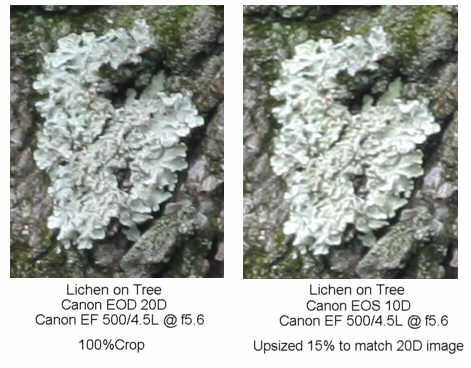 Above are two shots of a lichen on a distant tree, shot with a Canon EF 500/4.5L at f5.6. The 10D image has been upsized by 15% to match the scale of the 20D image. I think you can see that the level of detail is very similar. The 20D image, if you look very closely, does have more detail, but this is a large magnification. The crops are only 214 pixels wide, so they represent sections of an image which is 16x wider.
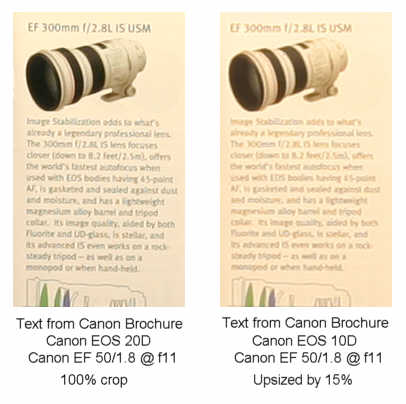 Above is a shot of a page from a Canon lens brochure, taken with a Canon EF50/1.8 lens at f11. Again the 10D image has been upsized by 15% to match the scale of the 20D image. Again, the difference is small, but the 20D image does show a little more detail. NoiseDespite the smaller pixels of the 20D, the noise levels have not increased over those of the 10D. In fact at high ISO settings, the 20D displays less noise than the 10D. Below is an extreme example. Noise is maximized at ISO 3200, in the red channel and at lower illumination levels. The 100% crops from the two shots below were taken at ISO 3200, of a red postage stamp and were underexposed by about a stop, then the histogram was stretched to bring up the brightness. This is about as cruel a test as you could devise to represent the most difficult shooting conditions.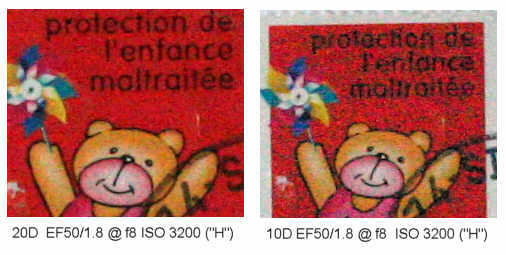 As you can see, the 20D image is significantly better than the 10D image. Better resolution, less noise. Of course as I said, this is a very severe test. Below is a 100% crop of a second test shot at ISO 800 of a more neutral toned subject in higher illumination (above) and a crop from a part of the image in the shadows (below). 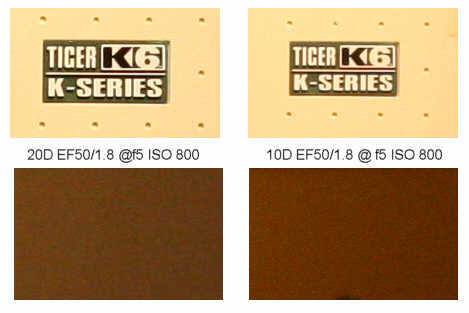 As you can see, there really isn't a significant difference here. Maybe a lab analysis of noise levels would show a difference, but from any practical viewpoint the noise level is essentially the same. Tests at ISO 400, 200 and 100 show lower and lower noise and very little difference between the 20D and 10D.
White BalanceLike the 10D the 20D has multiple white balance options: Auto, Sunny, Shady, Cloudy, Tungsten, Fluorescent, Flash, Custom and Kelvin Temperature. In general the white balance is pretty good in auto mode outdoors, but like the 10D and 300D, it's not so hot under tungsten light. For some reason all these Canon DSLRs have trouble under tungsten light in auto mode, and even in tungsten mode. Under fluorescent lighting they do much better whether in Auto or fluorescent mode. The samples below illustrate this.
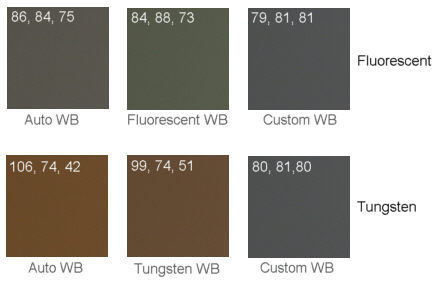 The target was a Kodak gray card and the numbers represent the Red, Green and Blue levels respectively. All the numbers should be the same for a true neutral balance. As you can see, the 20D does OK under fluorescent light, but not under tungsten. Compare this with my previous test on the Digital Rebel and you'll see it seems to be a Canon "feature". Maybe the 30D will be better. I have heard that maybe Canon deliberately has a "warm" tungsten balance rather than a neutral balance because people tend to like (or are at least used to) a "warm" look to indoor photographs taken under tungsten light. Not sure if this is true, but I guess it's possible. The 20D does provide white balance bracketing and white balance fine tuning via menu options, so you do have the ability to change or work around the default settings if they're not working well for you. The other options are to use custom white balance, which does work well (you first shoot a neutral target, then use that as your lighting reference), or you can shoot in RAW mode and adjust white balance "after the fact" during RAW conversion. Black and WhiteThe 20D has the ability to record images in black and white and to simulate several filters, red, orange, yellow and green. You can also sepia tone the resulting B&W image. This feature would be useful if you wanted to make B&W prints directly from the camera, or, I guess, if you wanted to see what the B&W image looked like on the LCD. However shooting in color and later converting in an image editor gives you far more flexibility to decide which "filter" effect looks best, or even to define your own "filter" settings. Though I do work in B&W, I doubt I'll make much use of the in-camera B&W setting.Flash I briefly tested the 20D with a 380EX speedlite and exposure and color balance seemed fine. I can't comment yet on the difference between E-TTL (10D) and E-TTL II (20D), but in the brief tests I did I didn't see any huge difference from the results with the 10D. The illuminator on the 380EX enabled autofocus in total darkness without a problem. The 20D body (like the 10D body) has no dedicated AF illuminator. In conditions where there isn't enough light for AF, the built in flash will strobe to provide illumination. In "green zone" and PIC modes the built in flash will pop up automatically. In the creative modes (M, Tv, Av, P etc.) the flash can be manually activated. As mentioned earlier in this review, the 20D can support a flash trigger voltage up to 250v (vs. 6v on the 10D and 300D) due to the use of a semiconductor switch rather than depending on a mechanical contact. Probably the best flash for the EOS 20D is the new 580EX Speedlite. It has a number of new features which are listed on my Canon 580EX Speedlite page. Note that there's currently a $20 rebate on the 580EX from Canon (see my rebates page. The rebate ends January 31st 2005. EF-S LensesThe EOS 20D is the second EOS body (the Digital Rebel was the first) to be equipped with an EF-S compatible lens mount. Three new EF-S series lenses were introduced along with the 20D, the EF-S 10-22/3.5-4.5 USM, EF-S 17-85mm f/4-5.6 IS USM and EF-S 18-55/3.5-5.6 USM. Full details of these lenses can be found on the EF-S lens page. The EF-S 10-22/3.5-4.5 USM is the widest lens available for the EOS 20D, giving a field of view equal to that of a 16-35 lens on a full frame 35mm camera.BatteryThe battery supplied with the 20D (BP-511A) has a higher capacity than that which was supplied with the 10D (BP-511), though they are interchangable. Along with reduced power consumption due to improvements in the electronics (Digic II chip) this (according to Canon) should allow up to 1000 shots (without flash) per charge. A battery grip (BG-E2) is also available allowing the use of two BP-511 batteries or an optional holder for 6xAA cells, as well as providing a vertical shutter release.
 ConclusionsWell, the EOS 20D is a better camera than the EOS 10D. The question is whether or not it's worth the cost for an EOS 10D owner to upgrade. I'd suggest 10D owners in such a position put a dollar value how much each of the following major features is worth to them.
Right now I'd say that the EOS 20D represents the "state of the art" in what might be called "prosumer" DSLRs, i.e. those selling in the region of $1500. If it meets your needs I can highly recommend it. Further reading:
[Visit the HOME PAGE to see what's new on the site]
© Copyright Bob Atkins All Rights Reserved |
|||||
|
|
